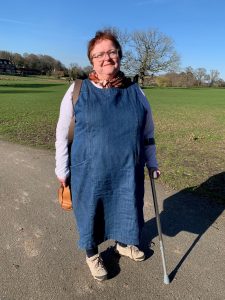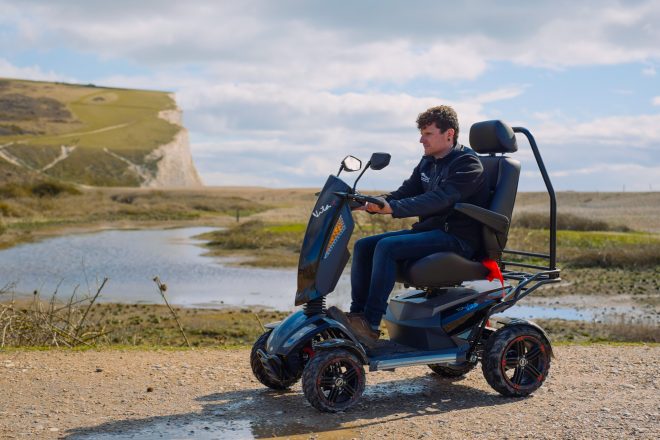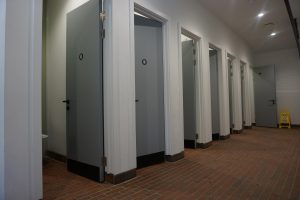Spotlight on disabled access in the South Downs National Park
March 13, 2024
Anita Kerwin-Nye recently took on the role of Director of Landscape and Strategy at the National Park following the retirement of her long-serving predecessor, Andrew Lee. For Disabled Access Day this month, Anita shines a spotlight on disabled access in the South Downs and shares her own thoughts and experiences.
 A wise friend said that we should design the world as if we were likely to be disabled at some point – because in truth most of us will be.
A wise friend said that we should design the world as if we were likely to be disabled at some point – because in truth most of us will be.
A significant knee injury puts me in this place. I am temporarily disabled. The countryside is a refuge, but accessing it can mean serious pain.
And I am currently typing this with an increased font size as my eyes make the shift to middle age!
Two of my children have neurodivergent conditions – which for one can manifest in extreme anxiety in new places. But both are better in the outdoor spaces with the connections to nature that we know have such a positive effect on well-being.
This is not a woes me, rather a recognition that the things we put into place to support those who have disabilities are of benefit to us all. My career history has been in access – from teaching children to taking children with disabilities on residentials and to my work at YHA taking a million children into the countryside.
I am therefore delighted to have joined SDNP as Director for Landscape and Strategy. I carry the brief for both of the National Park’s core purposes – having the responsibility to balance access for all with the conservation and enhancement of nature and heritage.
Of course some lack of access for people with disabilities/disabled people is physical. And in natural landscapes and heritage sites these things can be more challenging to address. A focus on accessible paths is important and – where we can – using easier to walk or wheel on surfaces, and having ‘Miles Without Stiles’, will help not just those with wheelchairs but also those with pushchairs, crutches, temporary injuries or those less steady on their feet.
When considering access it is probably worth remembering that one person’s challenging terrain is actually another person’s positive personal challenge – and vice versa. I supported a friend in the first wheelchair trek across the whole of the Hadrian’s Wall. A challenge most people would struggle with on foot. Whereas for me a walk of half a mile is a major milestone when I used to walk the whole South Downs Way.
We know that equipment can help access and we are delighted to have two Trampers available at the site we own at Seven Sisters and that several of our partners have them at sites throughout the Park.
 And practical amenities matter. The toilets at Seven Sisters are fully accessible and also unisex, with each toilet being entirely self-contained with a sink and floor to ceiling doors. We also have a Changing Places toilet at the country park and accessible disabled toilets at the South Downs Centre in Midhurst for the public and staff.
And practical amenities matter. The toilets at Seven Sisters are fully accessible and also unisex, with each toilet being entirely self-contained with a sink and floor to ceiling doors. We also have a Changing Places toilet at the country park and accessible disabled toilets at the South Downs Centre in Midhurst for the public and staff.
But as well as physical access how do we support those who communicate in different ways? In both Seven Sisters Country Park and interpretation we support across the Park, we ensure appropriate and clear font sizes, accessible language and a range of recorded experiences – including the brilliant Cuckmere Audio Trail (launched last year)
For those – like my children – who have anxiety or autism, loud noises, new situations and other sensory experiences can be a challenge. National Park staff have access to training in neurodiversity and many tourist places in the South Downs are now offering quiet sessions, the use of headphones or calm, chillout spaces, for lots of their shows or sessions where you can learn more about the history, culture and landscape of the National Park. Take a look at the Novium Museum in Chichester, Winchester Science Museum and Planetarium in Hampshire and Towner Eastbourne in Eastbourne.
This signposting to and working with others is an important part of our role. As we don’t own the majority of the land in the National Park, most of our work on access is in supporting others. Many of our grant funding schemes have supported disability access schemes and we work with special schools – and schools more widely – to have both day visits and ‘nights under the stars’ staying in the Park. We capture some of this at our accessibility hub and always welcome other examples that we can share.
![]()
And, lastly, a classic example of something that supports people with disabilities but actually supports us all. Benches. I am a bench bagger. I love that at Seven Sisters Country Park we have benches that include spaces for those in wheelchairs. And that some of our audio recordings play next to benches so that people can enjoy nature, heritage and a rest in one space. But for me – and I know it is controversial – this bench oversees the best view from the Park. And – this weekend – provided a valuable rest on a (very) short bimble along the South Downs Way.
There is always more we can do to increase disability access across the South Downs. Always good to hear what you think we do well and what we can improve. And for us all to have a view on where access adjustments can work for everyone.
